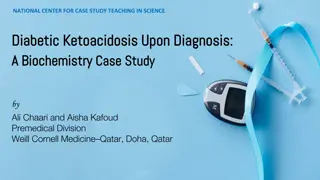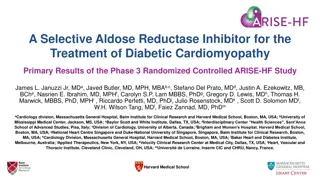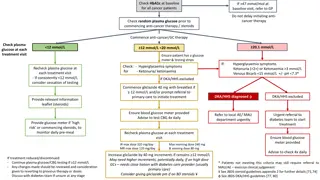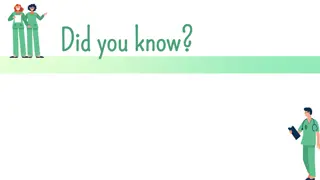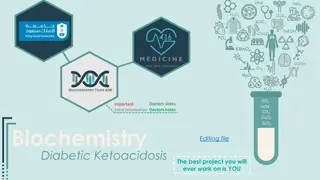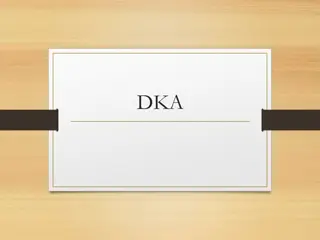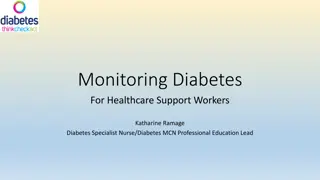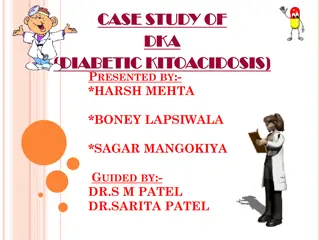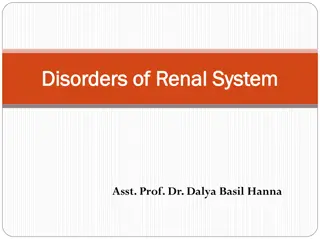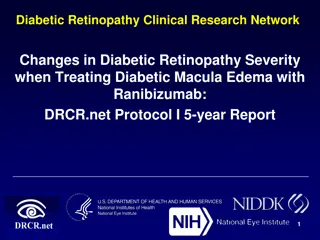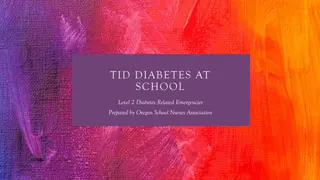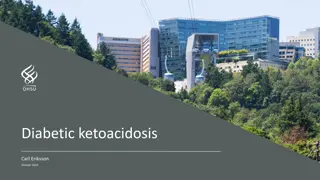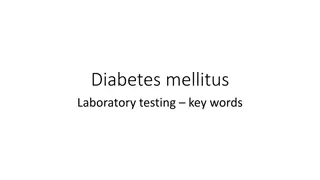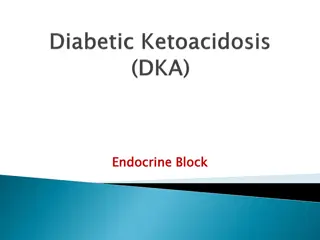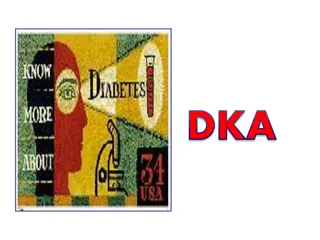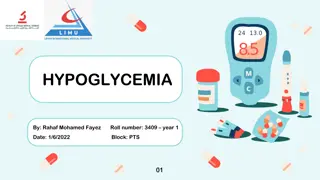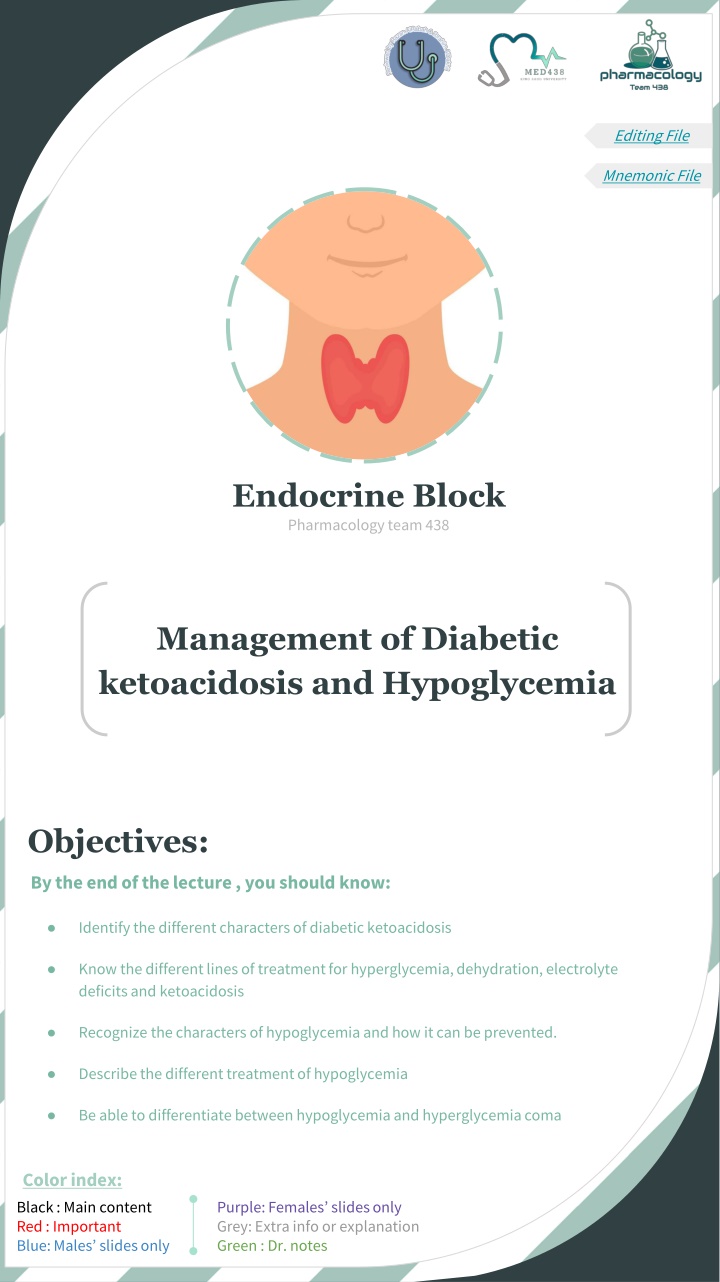
Management of Diabetic Ketoacidosis and Hypoglycemia: Understanding Treatment Options
Learn about diabetic ketoacidosis (DKA) and hypoglycemia, including their characteristics, symptoms, diagnostic criteria, and treatment options. Explore how to identify, differentiate, and manage these critical conditions effectively to prevent complications.
Download Presentation

Please find below an Image/Link to download the presentation.
The content on the website is provided AS IS for your information and personal use only. It may not be sold, licensed, or shared on other websites without obtaining consent from the author. If you encounter any issues during the download, it is possible that the publisher has removed the file from their server.
You are allowed to download the files provided on this website for personal or commercial use, subject to the condition that they are used lawfully. All files are the property of their respective owners.
The content on the website is provided AS IS for your information and personal use only. It may not be sold, licensed, or shared on other websites without obtaining consent from the author.
E N D
Presentation Transcript
Editing File Mnemonic File Endocrine Block Pharmacology team 438 Management of Diabetic ketoacidosis and Hypoglycemia Objectives: By the end of the lecture , you should know: Identify the different characters of diabetic ketoacidosis Know the different lines of treatment for hyperglycemia, dehydration, electrolyte deficits and ketoacidosis Recognize the characters of hypoglycemia and how it can be prevented. Describe the different treatment of hypoglycemia Be able to differentiate between hypoglycemia and hyperglycemia coma Color index: Black : Main content Red : Important Blue: Males slides only Purple: Females slides only Grey: Extra info or explanation Green : Dr. notes
Diabetic Ketoacidosis DKA It is a serious acute emergency situation that requires admission to hospital with a risk of death. It develops as a result of insulin deficiency It is a characteristic feature of type I diabetes but may occur with type II especially during stress. In absence of insulin, many metabolic changes can occur: Carbohydrates Proteins Fats Lipolysis & ketogenesis: Fat breakdown to free fatty acidsthen to acetyl CoA that is converted to ketone bodies (Acetoacetic acid, -hydroxybutyric acid and acetone) proteolysis thus providing amino acid as precursors for gluconeogenesis Glycogenolysis Gluconeogenesis Insulin deficiency lead to : glycogenolysis gluconeogenesis, protein catabolism Lipolysis Lipolysis Free fatty acids Hyperglycemia Ketone bodies glycosuria Ketonemia + ketonuria Osmotic diuresis Dehydration Acidosis Hyperglycemia-induced glucosuria, osmotic diuresis & severe fluid loss Fluid loss induces dehydration & electrolyte imbalance Metabolic acidosis induces hyperventilation(Kussmaul Breathing)
Characters of diabetic ketoacidosis 6. Polydipsia 1. Hyperglycemia 7. Dehydration 2. Glucosuria 8. Electrolytes imbalance 3. Osmotic diuresis 9. Metabolic acidosis 4. Polyuria 10. Ketogenesis (ketonemia, ketonuria) 5. Thirst Clinical symptoms for diabetic ketoacidosis Classic features of hyperglycemia (thirst, polyuria) 1 2 3 Nausea, vomiting, abdominal pain Tachycardia Mental status changes (confusion, coma) Ketotic breath (fruity, with acetone smell) Kussmaul Kien respiration (rapid & deep) 4 5 6 Diagnostic Criteria in diabetic ketoacidosis Serum bicarbonate level <15 mmol/L Blood glucose level > 250 mg/dl -Ketonemia -Ketonuria Arterial pH < 7.35 Treatment of diabetic ketoacidosis 1 Adequate correction of: 1. 2. Dehydration by: (fluid therapy) 3. Electrolyte deficit: (potassium therapy) Hyperglycemia by: (insulin) 4. Ketoacidosis: (bicarbonate therapy) Rehydration (fluid therapy) 01 Restore blood volume and perfusion of tissues. Infusion of isotonic saline (0.9% sodium chloride) at a rate of 15 20 ml/kg/hour or lactated Ringer solution. Insulin therapy (short acting insulin) Regular insulin, should be administered by means of continuous I.V infusion in small doses through an infusion pump (0.1 U/kg/h). Subcutaneous absorption of insulin is reduced in DKA because of dehydrationtherefore,intravenous routes are preferable. Insulin stops lipolysis and promotes degradation of ketone bodies. 02 Potassium therapy 03 potassium replacement must be initiated, added to infusion fluid to correct serum potassium concentration (to fix hypokalemia which can be worsened by insulin therapy too) Bicarbonate therapy For correction of metabolic acidosis bicarbonate therapy should be used only if the arterial pH < 7.0 after 1 hour of hydration, (sodium bicarbonate should be administered every 2 hours until the pH is at least 7.0). 04 1. symptomatic treatment
Hypoglycemia Blood sugar of less than 70 mg/dl is considered hypoglycemia. Is a life threatening disorder that occurs when blood glucose level becomes < 50 mg/dl One of the common side effects of insulin in treating type I diabetes. 1 2 Hypoglycemia can be an early manifestation of other serious disorders (sepsis, congenital heart disease, cerebral hemorrhage) Overdose of insulin or oral hypoglycemic drugs (sulfonylureas -meglitinides)1 Causes of hypoglycemia 4 3 Excessive physical exercise Missed or delayed meal Characters of hypoglycemia Neurological Autonomic 2 -headache, visual disturbance, slurred speech, dizziness -Tremors, mental confusion, convulsions -comadue to low glucose delivery to the brain - sympathetic: tachycardia, palpitation, sweating, anxiety, tremor. - parasympathetic: nausea, vomiting. Precautions: Hypoglycemia can be prevented by: Monitoring blood glucose level (blood sugar level should be checked routinely). 1 Patients should carry glucose tablets or hard candy to eat it if blood sugar gets too low. 2 Diabetic patient should wear a medical ID bracelet or carry a card. 3 -Patient should not skip meals or eat partial meals. -Patient should eat extra carbohydrates if he will be more active than usual 4 1. 2. Induced by insulin secretagogues only, and not insulin sensitizers (e.g. metformin, TZD) If the patient is on beta-blockers he may not experience the typical adrenergic warning symptoms
Treatment of hypoglycemia Drugs Glucagon Sugar Glucagon (1 mg S.C or I.M) 20-50 ml of 50% glucose solution I.V infusion. Sugar containing beverage or food (30 g orally). P.K Uses Unconsciouspatient Conscious patient. ADR Risk of possible phlebitis - Comparison between Hypoglycemic and Hyperglycemic coma Hyperglycemic coma (Diabetic Ketoacidosis) Type of Coma Hypoglycemic coma Cause Excess insulin Too little insulin Onset Rapid Slow -Over several days Acidosis and deHydration No Ketoacidosis B.P Normal Subnormal or in shock Respiration Normal or shallow Air hunger Skin Pale & Sweating Hot & dry Tremors, mental confusion, sometimes convulsions CNS General depression Blood sugar Lower than 70 mg/100cc Elevated above 200 mg/100cc Ketones Normal Elevated Conscious patient: oral glucose tablet, juice or honey. Unconscious patient: Treated by 20-50 ml of 50% glucose solution I.V infusion or glucagon (1 mg , S.C. or I.M.) Fluid therapy Insulin Potassium supplement Bicarbonate Treatment
Quiz MCQ 1. A patient presented with nausea, vomiting and persistent thirst, he had fruity smelling breath, blood glucose level was 330 mg/dL and arterial PH was 6.7. What is the first management step? A.bicarbonate therapy B. rehydration C. antiemetic D. admission for monitoring 2. Which of the following used to correct the acidosis in diabetic ketoacidosis after hydration? A.Potassium B. Insulin C. Glucagon D. Bicarbonate 3. Which of the following electrolyte deficiency happen in Diabetic ketoacidosis? A.Calcium B. Sulfate C. Uranium-235 D. Potassium 4. Which one of the following ADR caused by glucagon treatment for hypoglycemia? A. hypothermia B. Hypercalcemia C. Phlebitis D. Bradycardia 5. A 58 years old male who fall down due to hypoglycemic coma. What is the treatment in this situation? A. By giving him orange juice. B. By giving him I.V regular Insulin. C. By giving him I.M Glucagon. D. All of them. SAQ 1-A 10 years old child came to ER with fruity breath, he was with hot and dry skin, his mother said that his child tend to be thirsty all the time. The biochemical investigation shows (Blood glucose level : 267 mg/dl, Arterial PH :6.9, dehydration with ketonuria). Q1: What is the diagnosis? Q2: Mention all the lines of treatment to manage this case (STEPWISE) 2-A 48 years old woman who lost consciousness due to hypoglycemic coma. Q3: What is the treatment to manage this case? 3-A 13 years old girl with tremors and headache, she is known case for DM1, you suspect hypoglycemia. Q4: what is the management of this case? MCQ SAQ Q1 B Q1 Diabetic ketoacidosis Q2 D Q2 1.Isotonic saline (fluid therapy) 2. Insulin 3. Potassium replacement 4. Bicarbonate Answers: Q3 D Q3 I.M glucagon or I.V. Glucose solution Q4 C Q4 Oral glucose tablet, juice or honey Q5 C
Thank you for all your love and support. Good luck future doctors! Team Leaders: May Babaeer Zyad Aldosari This Magnificent Work was Done By: Alwaleed Alsaleh Mohaned Makkawi Hashem Bassam Note writers Nouf Alshammari Quiz writers Alwaleed alsaleh

